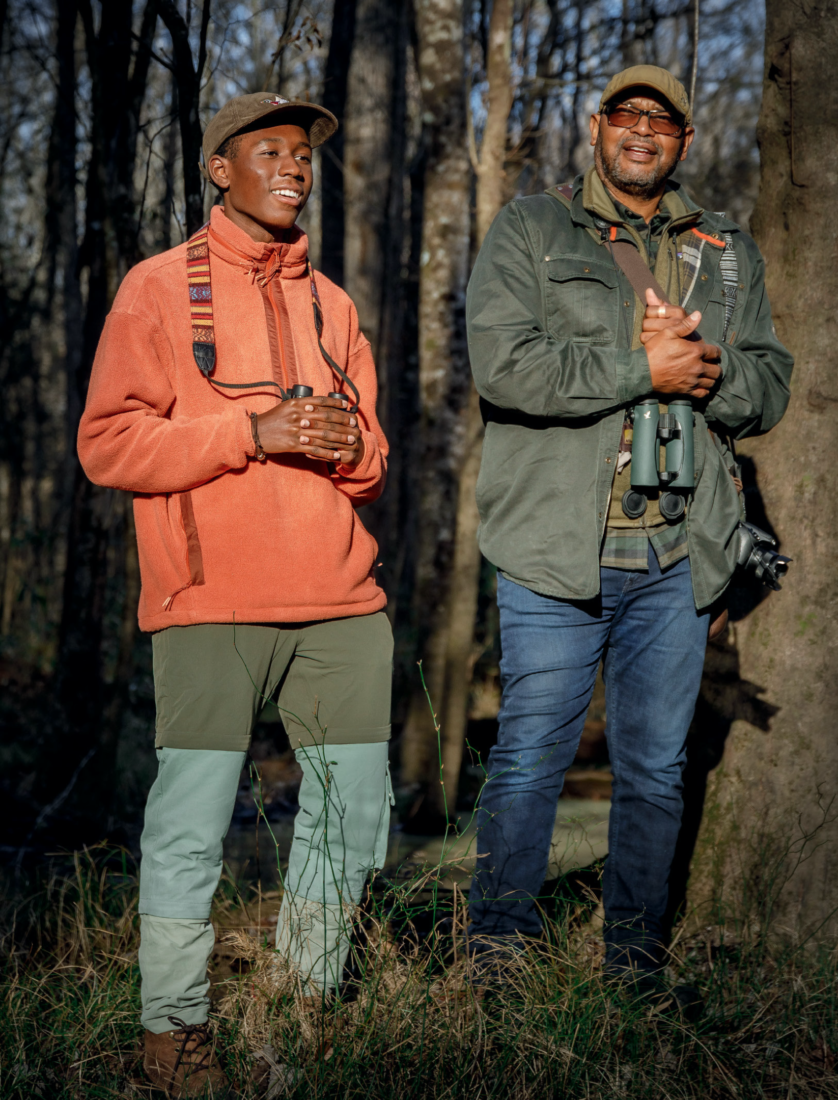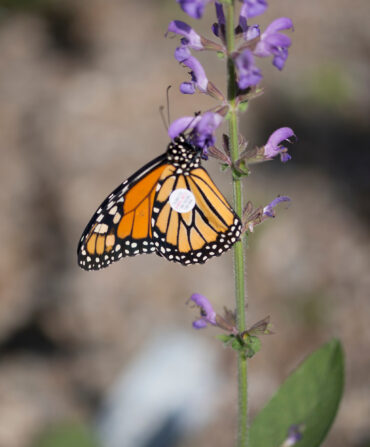The country has been in the grip of a freeze, and South Carolina has not been spared. To avoid black ice, J. Drew Lanham, a writer, poet, and wildlife biologist, has advised Isaiah Scott to arrive at Congaree National Park in the warmer afternoon to bird-watch. Lanham, a son of Edgefield, South Carolina, is meeting Scott for the first time. Scott has traveled up from Savannah to meet his mentor-from-afar; the eighteen-year-old enrolled last fall as a freshman at Cornell University, majoring in environment and sustainability and working with the Lab of Ornithology there, inspired in part by Lanham’s work.
In latter years, Lanham, the author of The Home Place, has turned to visual art, poetry, and creative nonfiction to express and explore the joys of nature and bird-watching and the complications of birding while Black. Scott, also a skilled artist and leader of his own bird-watching hikes, harnesses social media to tell his story. On the one side, each is a birder and nature lover; on the other, each navigates being a Black birder and Black nature lover, specifically. It is not a choice, but a tenuous balancing act. A coexistence that cannot be disentangled from the very landscape upon which they converge, the knees of Congaree’s bald cypresses recalling the rising hands of the enslaved Africans, known as Maroons, who once escaped and sought refuge here.
J. Drew Lanham: Congaree is South Carolina’s only national park and the largest old-growth forest in the Southeast. This is also the site of a lot of Black history, with the Maroons—how our ancestors really knew this place. How it sustained them, in body, mind, and spirit. Birds do that for us. They inspire us. You inspire me, Isaiah.
Isaiah Scott: [Grins.] You inspire me. I looked at Congaree history, and one of the first articles I found was one of the basic ones from the National Park Service. The first thing was prehistoric peoples. Then it was all about how logging companies were logging the area, but they couldn’t do a lot of logging because the water made it difficult. It didn’t mention anything about Maroon communities here. People who escaped slavery and pretty much saw this place as a safe haven to build communities and live off the land.
Lanham: For a lot of people, Black history is “slack” history. They’re like, “Oh, how long will it be before you mention the s word [slavery] or should I say the e word [enslaved]?” You’re dealing with public space, and people are reluctant to deal with that bitterness. So, in some of the places around the state that enslaved people built—for example, all of these rice impoundments down the coast—signage still reads, “servants” or “workers.” Hear that?
A high-pitched war cry peals across the forest bed.
Lanham: A pileated woodpecker. The closest thing to an ivory-billed [woodpecker] but smaller. There are actually three or four of them in there.
While Congaree does include history about Maroons on some pages of its website and map guides, and in its gift shop, Lanham and Scott’s point is not lost. Lanham, in fact, has made it his mission to relate social history to nature and ecology in his teaching and writing.
Lanham: The big deal now that nobody’s talking about is this snowy owl in D.C. Heard about it?
Scott: I actually haven’t.
Lanham: It’s perched near the [National] Mall on flagpoles. It’s doing its thing. And so birders are going there to see it. You’ve got birders stepping over homeless people with $10,000 lenses in their hands. My friend told me about a homeless man who was making bird calls to try to get their attention. The point is, you have to take your binoculars down and not just think about the next bird on the list.
Scott discovered the ornithologist’s work through Lanham’s YouTube tutorial “The Rules for the Black Birdwatcher,” in which Lanham explains the essential tools for birders: “your binoculars, your spotting scope, your field guide. And if you’re Black,” he adds, “you’re gonna need probably two or three forms of ID.”
Scott: I love that video. I was like, “Oh my gosh…there are Black birders. This is awesome.” It really encouraged me to keep going, and I was really inspired by that, when I discovered you through that video. And things you talked about, like pretty much never wear a hoodie.
A “teedle teedle toodle teedle toodle”
Lanham: Do you hear that? That is a ruby-crowned kinglet singing.
Scott listens, and as they continue along the boardwalk, he tells Lanham about his own project.
Scott: I’m working on a book that I received grant funding for through Drexel University called the Eckelberry Fellowship. The book is an illustrated guide that traces the connection between African peoples and birds throughout time, from the West African coast to Barbados to Charleston and the Gullah Geechee corridors. The rice fields that enslaved Africans forged, for example, created a habitat for a lot of rail species, like black rails and king rails and a lot of other waterfowl during the winter. And today these rice fields are still used for bird conservation and creating habitats for migratory waterfowl and shorebirds, but we don’t talk about the human toll.
Lanham, too, is currently working on a book project, one that will advocate for a more humanistic approach and sensibility to birding.
Lanham: I mean, your binoculars—you can see things really great [with them], but it’s a really limited field of view. What is the broader context? The same place that we can go in this state—Allendale County—to see twenty to thirty swallow-tailed kites at once, fifty or sixty Mississippi kites, is also one of the poorest counties in the nation. But birders will go there and see swallow-tailed kites and Mississippi kites and leave without having impacted the people.
Beyond books and articles, Lanham, and particularly Scott, have used social media to reach new audiences. The pandemic and the renewed reckoning with racial injustice have created opportunities for Scott to amplify his voice.
Scott: [Through Instagram], I began to get recognized by companies and organizations to do talks. L.L.Bean reached out through DM [direct message], like, “Hey, we’d love to work with you.” Nocs binoculars’ founder, Chris McKleroy, reached out to me and wanted to do content with his binoculars, and now he’s a good friend.
Lanham: That’s one of the things that you can learn from his generation, from younger folks, is how to leverage what you love.
The pandemic provided time for Scott to paint, including his line of note cards featuring gouache birds. For Lanham, the pandemic brought more introspection.
Lanham: For me, honestly, it’s been a struggle. Luckily, I’m still breathing. We’re dealing with a viral pandemic, injustice. Breathing is a blessing. I think, for me, birding became intensely local. I wasn’t able to travel all over the country, the world, like I had been doing. Suddenly, the backyard became the world, and the birds had to bring the rest of the world to me.
At the visitor’s center, teacher and protégé reflect on their time together.
Scott: You know, Drew, I wouldn’t be doing this if it weren’t for you. Just knowing there was another Black birder out there, doing great things. I wouldn’t have been encouraged to keep birding and keep going.
Lanham: Well, I’m an Isaiah fan. You’re all about birds, you’re all about beauty, you’re all about the love of all this. Conservation comes down to how we care about something. So I’m grateful to you, inspired by you, as you open new frontiers for birding.








